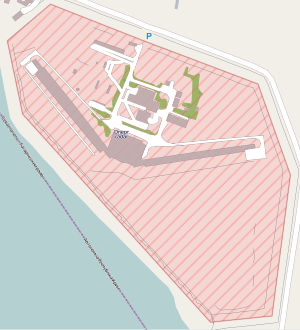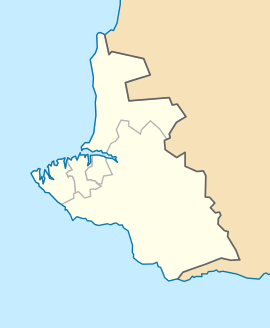Sevastopol Radar Station
Sevastopol radar station was a Soviet radar station providing early warning of ballistic missile attack. It is located between the Cape of Chersones and the auxiliary airfield "Chersones" (Marine Aviation of the Black Sea Fleet) in Sevastopol and was part of the Soviet missile attack warning system. Information from this station could be used for a launch on warning nuclear missile attack[3] or to engage the A-135 anti-ballistic missile system.
| Sevastopol radar station | |
|---|---|
| Sevastopol, Ukraine | |
 Plan of the site showing the two wings of the Dnepr overlooking the Black Sea | |
 Sevastopol radar station | |
| Coordinates | 44.5788°N 33.3862°E |
| Type | Radar station |
| Code | RO-4 [1] |
| Height | 75 metres (246 ft)[2] |
| Site information | |
| Condition | ruined? |
| Site history | |
| Built | 1968- |
| Built by | Soviet Union |
The radar occupies a site 1 km long overlooking the Black Sea. Nearby there is a former Soviet Navy dolphinarium[4] and a former airfield. When the station was built it was in the then-closed town of Sevastopol, in the Ukrainian SSR.
Radar
The radar is a Dnepr (NATO name "Hen House") phased array radar. It consists of a central building and two long wings over 250 metres long; each wing is a separate radar array. One had an azimuth of 172° (facing south) and the other 230° (facing south-east).[5] The radar had a range of 3,000 kilometres (1,900 mi) covering southern Europe, North Africa and parts of the Middle East.[6][7]
Construction began on the radar in the late 1960s.[8] Some sources say that it started operating in 1975,[8][9] others say it became fully operational on 16 January 1979.[5][7]
Dispute with Ukraine
In 1991 the Soviet Union collapsed and the station ended up in the newly independent country of Ukraine, together with the radar in Mukachevo. Russia signed a 15-year agreement with Ukraine in 1992 to rent both radars for $840,000 per year, although unlike other overseas stations the radar was to be staffed by Ukrainians not Russians.[10][11] In 2005 management of the radars was transferred from the military to the civil Ukrainian National Space Agency and the rent increased to $1.3 million, although Ukraine asked for more.[7][12]
In 2008 Russia decided to stop using information from the two Ukrainian radar stations.[13][14] According to some commentators it was partly because of the then Ukrainian government's stated intention to join NATO.[10][13] In 2007 the then commander of the Russian Space Forces, Vladimir Popovkin, stated that Russia intended to duplicate or replace foreign radar stations as it could not rely on them in times of crisis.[15] Replacing the station would reduce any leverage Ukraine was gaining over Russia from its ability to control access to the data.[10][11][16]
Pragmatic reasons were given for ending the lease. Popovkin said that the radars went out of warranty in 2005, and would cost $20m to modernise. In addition Russia said that the data from Sevastopol was unreliable due to interference from unlicensed radio broadcasts from fishing boats in the Black Sea.[13][14] Furthermore, it had concerns with the quality of the data due to the civilian rather than military operators.[13][17]
Data from Ukraine stopped on 26 February 2009 and Russia declared that a new Voronezh radar station in Armavir had begun operation on the same date, replacing the lost coverage.[18][19]:76 Following this the Ukrainian government announced that the stations would be closed for a month for maintenance and then used part-time for space surveillance, being part of an organisation called SKAKO (Automatic System of Control and Analysis of Outer Space).[20][21]
| External image | |
|---|---|
Returning to Russia
Following the annexation of Crimea by the Russian Federation, the new Russian administration announced it was considering having the site modernized and fully re-opened by 2018.[22][23] This is to offset the threat of the NATO radar site in Romania, as the Mk-41 launchers there are capable of launching Tomahawk cruise missiles,[24] which Russia says violates the 1987 INF Treaty. However due to the age of the system and its derelict state that timetable appears not to have been met, no reopening announcement having been made by December 2019.
References
- Всевидящий глаз России [Seeing Eye Russia]. Novosti Kosmonavtiki (in Russian). Eastview (5): 52–53. May 2009.(subscription required)
- Bukharin, Oleg; Kadyshev, Timur; Miasnikov, Eugene; Podvig, Pavel; Sutyagin, Igor; Tarashenko, Maxim; Zhelezov, Boris (2001). Podvig, Pavel (ed.). Russian Strategic Nuclear Forces. Cambridge, Massachusetts: MIT Press. ISBN 978-0-262-16202-9.
- Podvig, Pavel (1994). "The Operational Status of the Russian Space-Based Early Warning System" (PDF). Science and Global Security. 4 (3): 363–384. doi:10.1080/08929889408426407. ISSN 0892-9882.
- "Iran buys kamikaze dolphins". BBC News. 2000-03-08. Retrieved 2012-07-09.
- Podvig, Pavel (2002). "History and the Current Status of the Russian Early-Warning System" (PDF). Science and Global Security. 10: 21–60. CiteSeerX 10.1.1.692.6127. doi:10.1080/08929880212328. ISSN 0892-9882. Archived from the original (PDF) on 2012-03-15.
- Мощные РЛС дальнего обнаружения РЛС СПРН и СККП [Powerful radar early warning radar early warning system and space surveillance] (in Russian). RTI Mints. n.d. Archived from the original on 2012-12-02. Retrieved 2012-01-30.
- "Russia Won't Rent Ukrainian Radar". Kommersant. 2008-01-16. Retrieved 2012-01-30.
- Ivantsov, Viktor (n.d.). От "Днестра" до "Днепра" [From the Dnestr to the Dnepr] (in Russian). VKO.ru. Archived from the original on 2012-12-02. Retrieved 2012-07-11.
- Marinin, I (2011). Отечественной СПРН – 40 лет [Patriotic SPRN - 40 years] (in Russian). Novosti Kosmonavtiki. Archived from the original on May 20, 2012. Retrieved 20 June 2012.
- Wilk, Andrzej (2008-01-29). "Russia starts to dismantle the Soviet early warning system". Centre for Eastern Studies. Archived from the original on 2012-12-02. Retrieved 2012-07-09.
- Kramnik, Ilya (2009-02-26). Арифметика СПРН: минус два "Днепра", плюс один "Воронеж" [Early warning arithmetic: minus two Dnepr, plus one Voronezh] (in Russian). RIA Novosti. Retrieved 2012-07-15.
- "Ukraine Sends a Warning to Russia". Kommersant. 2005-02-11. Retrieved 2012-07-11.
- "Russia to stop using Ukrainian radars". RIA Novosti. 2008-02-04. Retrieved 2012-01-30.
- Podvig, Pavel (2008-02-25). "Russia pulls out of an early-warning arrangement with Ukraine". Russian strategic nuclear forces. Retrieved 2012-02-01.
-
Marinin, I; Kuznetsov, A (February 2007). "THE FIRST VORONEZH ON EXPERIMENTAL COMBAT DUTY". Novosti Kosmonavtiki. Eastview (2): 64–65. Retrieved May 2012. Check date values in:
|accessdate=(help)(subscription required) - "Russia will deploy the new early-warning radar deal with U.S. anti-missile system in Eastern Europe". 9ABC [Chinese Military]. 2011-02-09. Archived from the original on 2013-02-21. Retrieved 2012-07-10.
- Podvig, Pavel (2007-07-13). "Russia will no longer use early-warning radars in Ukraine". Russian strategic nuclear forces. Retrieved 2012-02-01.
- Podvig, Pavel (2009-02-12). "Armavir radar fills the gap". Russian strategic nuclear forces. Retrieved 2012-01-09.
- Baev, Pavel (2010). "Neither Reform nor Modernisation: the Armed Forces Under and After Putin's Command". In Galeotti, Mark (ed.). The Politics of Modern Security in Russia. Ashgate. pp. 69–88. ISBN 978-0-7546-7408-5.
- "Ukrainian radars withdrawn from operation in Russia's interests to undergo technical maintenance". Kyiv Post. 2009-02-26. Retrieved 2012-07-11.
- "Source: Ukraine radar to be used to protect German satellites". Kyiv Post. 2010-02-09. Retrieved 2012-07-11.
- РЛС "Днепр" в Севастополе заступит на боевое дежурство в 2016 году [The Dnepr radar in Sevastopol brings on combat duty in 2016] (in Russian). RIA Novosti. 2014-10-04.
- RT (May 17, 2016): Russia to counter NATO expansion with new radar station in Crimea
- TASS (May 12, 2016): Russian envoy: NATO base in Romania poses considerable risk to Russian security